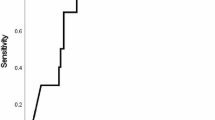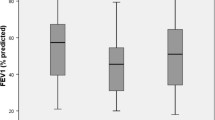Abstract
Circulating C-reactive protein (CRP) plays an important role in mediating extra-pulmonary complications of chronic obstructive pulmonary disease (COPD). The aim of this study was to investigate the relationship between changes in high sensitivity (hs)-CRP levels and the resolution of airway inflammatory markers and clinical health status during the recovery period after an acute exacerbation of COPD (AECOPD). Consecutive patients hospitalized for AECOPD were recruited. Serum hs-CRP, airway inflammatory markers, and COPD Assessment Test (CAT) score were evaluated at admission prior to treatment and at days 4, 7, and 14. Adverse outcomes were recorded. The relationship between changes in airway inflammatory markers, CAT score, and hs-CRP during the recovery period was studied. A total of 135 patients were enrolled. Serum hs-CRP levels at admission of patients with adverse outcomes were marginally higher than those without an adverse outcome (7.6 [4.8, 16.7] vs. 6.6 [4.7, 9.3], p = 0.061). Compared with patients without cardiovascular complications, patients with cardiovascular complications had higher serum hs-CRP levels at admission (11.6 [6.7, 16.7] vs. 6.6 [4.4, 10.0], p = 0.001). Sputum neutrophils were positively correlated to hs-CRP at admission (r = 0.474, p < 0.001). A decreasing hs-CRP level was positively related to decreasing sputum neutrophils at day 4 and 7 (r = 0.455, p < 0.001; r = 0.504, p < 0.001, respectively). Significant correlations between decreasing hs-CRP and CAT at all time-points were noted. Hs-CRP may be useful in monitoring airway inflammation resolution and improvement of health status during AECOPD treatment.

Similar content being viewed by others
References
Sapey E, Stockley RA (2006) COPD exacerbations. 2: aetiology. Thorax 61(3):250–258
Joppa P, Petrasova D, Stancak B, Tkacova R (2006) Systemic inflammation in patients with COPD and pulmonary hypertension. Chest 130(2):326–333
Miniati M, Monti S, Bottai M, Cocci F, Fornai E, Lubrano V (2011) Prognostic value of C-reactive protein in chronic obstructive pulmonary disease. Intern Emerg Med 6(5):423–430
Dahl M, Vestbo J, Lange P, Bojesen SE, Tybjaerg-Hansen A, Nordestgaard BG (2007) C-reactive protein as a predictor of prognosis in chronic obstructive pulmonary disease. Am J Respir Crit Care Med 175(3):250–255
Stolz D, Christ-Crain M, Morgenthaler NG et al (2007) Copeptin, C-reactive protein, and procalcitonin as prognostic biomarkers in acute exacerbation of COPD. Chest 131(4):1058–1067
Tofan F, Rahimi-Rad MH, Rasmi Y, Rahimirad S (2012) High sensitive C-reactive protein for prediction of adverse outcome in acute exacerbation of chronic obstructive pulmonary disease. Pneumologia 61(3):160–162
Antonescu-Turcu AL, Tomic R (2009) C-reactive protein and copeptin: prognostic predictors in chronic obstructive pulmonary disease exacerbations. Curr Opin Pulm Med 15(2):120–125
Karadeniz G, Polat G, Senol G, Buyuksirin M (2013) C-reactive protein measurements as a marker of the severity of chronic obstructive pulmonary disease exacerbations. Inflammation 36(4):948–953
Koutsokera A, Kiropoulos TS, Nikoulis DJ et al (2009) Clinical, functional and biochemical changes during recovery from COPD exacerbations. Respir Med 103(6):919–926
Rabe KF, Hurd S, Anzueto A et al (2007) Global strategy for the diagnosis, management, and prevention of chronic obstructive pulmonary disease: GOLD executive summary. Am J Respir Crit Care Med 176(6):532–555
Hurst JR, Vestbo J, Anzueto A et al (2010) Susceptibility to exacerbation in chronic obstructive pulmonary disease. N Engl J Med 363(12):1128–1138
Anthonisen NR, Manfreda J, Warren CP, Hershfield ES, Harding GK, Nelson NA (1987) Antibiotic therapy in exacerbations of chronic obstructive pulmonary disease. Ann Intern Med 106(2):196–204
Mahler DA, Wells CK (1988) Evaluation of clinical methods for rating dyspnea. Chest 93(3):580–586
Gleckman R, DeVita J, Hibert D, Pelletier C, Martin R (1988) Sputum gram stain assessment in community-acquired bacteremic pneumonia. J Clin Microbiol 26(5):846–849
Ruiz-Gonzalez A, Lacasta D, Ibarz M, Martinez-Alonso M, Falguera M, Porcel JM (2008) C-reactive protein and other predictors of poor outcome in patients hospitalized with exacerbations of chronic obstructive pulmonary disease. Respirology 13(7):1028–1033
Szmitko PE, Wang CH, Weisel RD, de Almeida JR, Anderson TJ, Verma S (2003) New markers of inflammation and endothelial cell activation: part I. Circulation 108(16):1917–1923
Szmitko PE, Wang CH, Weisel RD, Jeffries GA, Anderson TJ, Verma S (2003) Biomarkers of vascular disease linking inflammation to endothelial activation: part II. Circulation 108(17):2041–2048
Thomsen M, Dahl M, Lange P, Vestbo J, Nordestgaard BG (2012) Inflammatory biomarkers and comorbidities in chronic obstructive pulmonary disease. Am J Respir Crit Care Med 186(10):982–988
Man SF, Connett JE, Anthonisen NR, Wise RA, Tashkin DP, Sin DD (2006) C-reactive protein and mortality in mild to moderate chronic obstructive pulmonary disease. Thorax 61(10):849–853
Gudmundsson G, Ulrik CS, Gislason T et al (2012) Long-term survival in patients hospitalized for chronic obstructive pulmonary disease: a prospective observational study in the Nordic countries. Int J Chron Obstruct Pulmon Dis 7:571–576
Ghoorah K, De Soyza A, Kunadian V (2013) Increased cardiovascular risk in patients with chronic obstructive pulmonary disease and the potential mechanisms linking the two conditions: a review. Cardiol Rev 21(4):196–202
Valipour A, Schreder M, Wolzt M et al (2008) Circulating vascular endothelial growth factor and systemic inflammatory markers in patients with stable and exacerbated chronic obstructive pulmonary disease. Clin Sci (Lond) 115(7):225–232
Hurst JR, Perera WR, Wilkinson TM, Donaldson GC, Wedzicha JA (2006) Systemic and upper and lower airway inflammation at exacerbation of chronic obstructive pulmonary disease. Am J Respir Crit Care Med 173(1):71–78
Gompertz S, O’Brien C, Bayley DL, Hill SL, Stockley RA (2001) Changes in bronchial inflammation during acute exacerbations of chronic bronchitis. Eur Respir J 17(6):1112–1119
Papi A, Bellettato CM, Braccioni F et al (2006) Infections and airway inflammation in chronic obstructive pulmonary disease severe exacerbations. Am J Respir Crit Care Med 173(10):1114–1121
Garrod R, Marshall J, Barley E, Fredericks S, Hagan G (2007) The relationship between inflammatory markers and disability in chronic obstructive pulmonary disease (COPD). Prim Care Respir J. 16(4):236–240
Broekhuizen R, Wouters EF, Creutzberg EC, Schols AM (2006) Raised CRP levels mark metabolic and functional impairment in advanced COPD. Thorax 61(1):17–22
Mackay AJ, Donaldson GC, Patel AR, Jones PW, Hurst JR, Wedzicha JA (2012) Usefulness of the chronic obstructive pulmonary disease assessment test to evaluate severity of COPD exacerbations. Am J Respir Crit Care Med 185(11):1218–1224
Maestrelli P, Saetta M, Di SA et al (1995) Comparison of leukocyte counts in sputum, bronchial biopsies, and bronchoalveolar lavage. Am J Respir Crit Care Med 152(6 Pt 1):1926–1931
Zhu J, Qiu YS, Majumdar S et al (2001) Exacerbations of Bronchitis: bronchial eosinophilia and gene expression for interleukin-4, interleukin-5, and eosinophil chemoattractants. Am J Respir Crit Care Med 164(1):109–116
Fujimoto K, Yasuo M, Urushibata K, Hanaoka M, Koizumi T, Kubo K (2005) Airway inflammation during stable and acutely exacerbated chronic obstructive pulmonary disease. Eur Respir J 25(4):640–646
Aaron SD, Angel JB, Lunau M et al (2001) Granulocyte inflammatory markers and airway infection during acute exacerbation of chronic obstructive pulmonary disease. Am J Respir Crit Care Med 163(2):349–355
Sethi S, Muscarella K, Evans N, Klingman KL, Grant BJ, Murphy TF (2000) Airway inflammation and etiology of acute exacerbations of chronic bronchitis. Chest 118(6):1557–1565
Qiu Y, Zhu J, Bandi V et al (2003) Biopsy neutrophilia, neutrophil chemokine and receptor gene expression in severe exacerbations of chronic obstructive pulmonary disease. Am J Respir Crit Care Med 168(8):968–975
Han MK, Agusti A, Calverley PM et al (2010) Chronic obstructive pulmonary disease phenotypes: the future of COPD. Am J Respir Crit Care Med 182(5):598–604
Acknowledgments
This work was supported by a grant from the National Natural Science Foundation of China (81400017).
Conflict of interest
None.
Ethical Standard
This study was reviewed by Peking University Third Hospital Medical Science Research Ethics Committee and arbitrated as not systematic research.
Author information
Authors and Affiliations
Corresponding author
Rights and permissions
About this article
Cite this article
Liang, Y., Chang, C., Zhu, H. et al. Correlation between decrease of CRP and resolution of airway inflammatory response, improvement of health status, and clinical outcomes during severe acute exacerbation of chronic obstructive pulmonary disease. Intern Emerg Med 10, 685–691 (2015). https://doi.org/10.1007/s11739-015-1228-2
Received:
Accepted:
Published:
Issue Date:
DOI: https://doi.org/10.1007/s11739-015-1228-2




